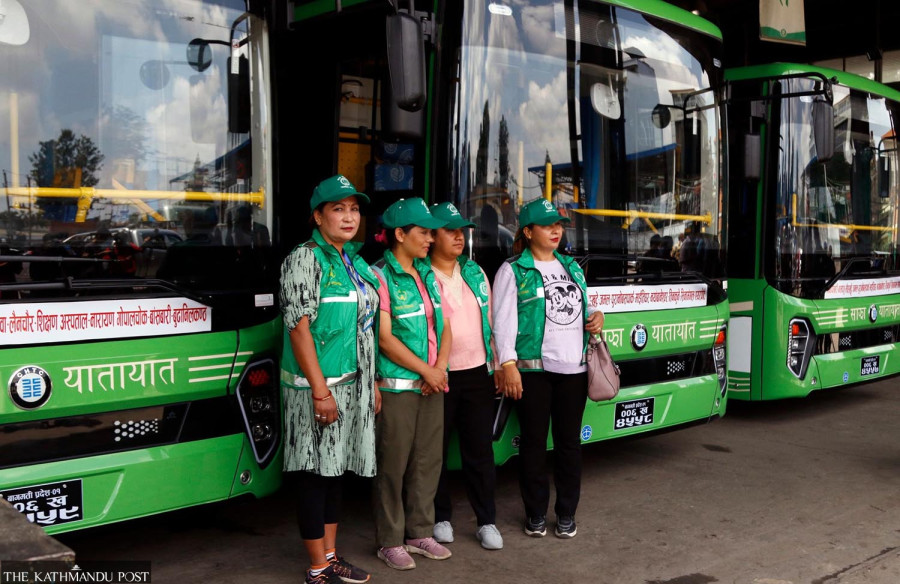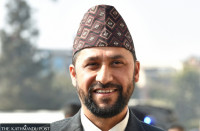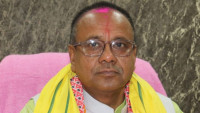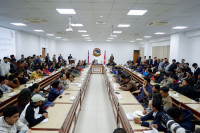National
Youngest female electric bus driver on the road less travelled
Nisha Chaulagain, the youngest female driver of Sajha Yatayat e-buses, says she joined Sajha to break through into a male-dominated profession and out of her love for driving.
Anup Ojha
When Nisha Chaulagain was selected for a three-month driving training for the new Sajha Yatayat electric buses in late March, her octogenarian grandmother, Debsara, was quite skeptical.
“She would ask me every day if I would be able to drive a big bus in a congested city,” said Chaulagain, one of the youngest female drivers at Sajha Yatayat.
After the training, Debsara has become less skeptical about her granddaughter driving a bus, a profession that is considered a male domain.
The 25-year-old now drives a 26-seater electric bus that came into operation recently in the Valley with the transportation cooperative launching three new e-buses on June 7.
“My family is very supportive of what I do,” said Chaulagain, who is also the youngest female of her 10-member family. “My grandmother was initially unsure of the profession I chose but now she calls me her bravest grandchild.”
Her grandmother, who moved to Kathmandu almost a decade ago from Kavrepalanchok, had never seen a female driver, says Chaulagain.
“She’s never heard of a woman driving a public vehicle but now she’s understood that I am here to break the glass ceiling,” Chaulagain said. “She now knows that if a man can drive a bus, so can a woman.”
Chaulagain’s parents run a tea shop at Jawalakhel while her older brother owns a fruit shop. Her younger brother is a plumber.
After her training, Chaulagain is on leave from her job to prepare for her Bachelor’s exams. A second-year student at Patan Multiple Campus majoring in Population and Sociology, she says she is excited to get her hands back on the wheel after her exams.
“I am the youngest driver there and I feel so proud to be driving an environment-friendly bus,” said Chaulagain. “This is my contribution to a clean Kathmandu. I am going back to work next week.”
Chaulagain, born in Kamane ward-7 in Hetauda, was brought up in Kusunti, Lalitpur. As a school kid, she was fascinated by the mechanisms of big vehicles such as buses and trucks. “I wanted to learn to drive. Most bus drivers are men and I wanted to become one of the first female bus drivers,” she said. “My older brother drove a taxi for a while and he taught me the basics of driving after my SLC.”
While she was in high school in Patan, she joined a driving school in Kusunti. She soon became an instructor and was employed with the same driving school for a year and a half. By the age of 21, she got her licence for light vehicles and a job as a prepaid metro taxi driver for Nepal Mediciti Hospital, Bhainsepati.
Later she worked for a judge at Patan High Court as driver for two years. She got her licence for heavy vehicles on November 29 last year.
“For women, if they become skilful drivers, there are plenty of opportunities in the driving profession,” said Chaulagain, who looks up to Rebika Thapa and Harmita Shrestha, two senior female drivers of the Sajha Yatayat, as her mentors.
“Rebika was the first woman bus driver in Sajha Yatayat and I was inspired by her. Because I could see these older sisters breaking the stereotype, I felt like I could do it too,” said Chaulagain. “Now I feel proud to be a part of their team.”
Sajha Yatayat has not only hired female drivers but has also employed female conductors. There are currently five female conductors hired last week, hinting at a shift in gender roles in the driving sector.

“It feels good to see Chaulagain, a very young female driver joining Sajha,” said Usha Sapkota, 23, who has been working as a conductor for the past three years with the cooperative.
“Earlier, I used to feel this job was odd. But the increase in the number of women conductors has given me more confidence,” added Sapkota, who is originally from Panauti in Kavre.
Harmita Shrestha, 45, who has been working with Sajha Yatayat as a driver for the past five years, said Chaulagain’s entry as the youngest female bus driver has opened the avenue for other aspiring female drivers.
Shrestha recalls her own journey from driving tempos to four-wheelers to buses.
“When I started driving a bus, there were very few women,” Shrestha said. “Now we are more in number but I still feel a slight pushback from society because people still don’t trust female drivers.” She advises women who want to gain financial independence to start taking driving lessons. “Unemployment among women is high. And learning to drive a vehicle will open job opportunities for them.”
“The problem is so far this field has been dominated by men but with women like Chaulagain entering the field, we might be able to change that,” she said.
To change the perception of women being bad drivers compared to men, Shrestha suggests the government become more inclusive and encourage women to drive public vehicles. “It’s safer to have female drivers because not many women drivers drink and drive. We are more committed to our job than men,” said Shrestha.
Shrestha said that an educated woman like Chaulagain joining the drivers’ workforce sends a positive message. “Drivers, male or female, are looked down upon. But to have even educated people choosing to become drivers takes our profession to another level of respect,” said Shrestha.
She, however, said that being a career-oriented woman in any field is a balancing act. “Married women who choose to have a career have to manage both work and home. It’s not different for female drivers. We have to take care of our family’s needs and be efficient at work. So it’s definitely not a cakewalk.”
According to Hari Ram Mishra, a supervisor at Sajha Yatayat, the company is yet to introduce special provisions for women drivers but they can avail of special leaves for family or health emergencies. “For unmarried independent women like Chaulagain, it’s easier to manage a job. For married women, it’s quite difficult to give 12 hours from 6am to 6pm to a job,” said Mishra.
Sajha Yatayat requires a driver to have five years of experience with a licence for heavy vehicles. Most women drivers fail to meet this criterion. But for Chaulagain, that was not a problem.
“When I went for my driving trial for heavy vehicles, most of the men present there were not sure if I would pass,” said Chaulagain. “While most men failed the trail, I passed it in one go.”
According to the Department of Transport Management, one can sit for a trial for a heavy vehicle after two years of driving light vehicles.
“We have had only a few women drivers associated with the Sajha Yatayat long-term,” said Namraj Ghimire, former director general at the Transport Department. “A decade ago, people would be surprised to see female drivers, but of late, people are getting used to seeing a woman behind the wheel.”
Sajha Yatayat’s chairperson Kanak Mani Dixit said the cooperative’s goal is to provide equal opportunities to men and women to live a dignified life as employees of Sajha Yatayat, but female drivers are fewer due to various reasons, including society’s perception of the driving profession.
“We intend to hire more women, and have already started working on that. This is just the beginning,” Dixit said. “Right now, we have a few women, and they are our success story.”
Meanwhile, Chaulagain said she joined Sajha Yatayat mostly to break through into a male-dominated profession and for her love for driving.
“I wanted to do something different and bring a difference to society,” said Chaulagain, adding she aims to encourage more women to join the workforce in future.
“Having women drivers and conductors creates a safe environment for passengers,” she said. “It will also put an end to sexual harassment faced by women in public vehicles.”




 16.12°C Kathmandu
16.12°C Kathmandu.jpg)















